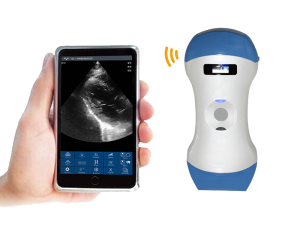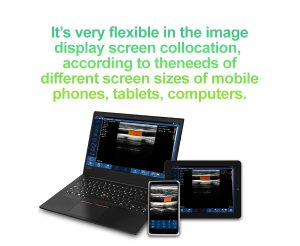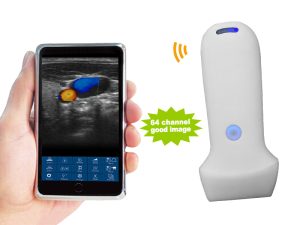Handheld wireless color Doppler ultrasound technology has transformed the field of medical diagnostics, offering a range of benefits that have made it an essential tool for healthcare professionals. This portable and versatile imaging device is widely used in various specialties such as cardiology, anesthesiology, emergency medicine, vascular medicine, and primary care, enabling more accurate, real-time diagnoses and improving patient outcomes. Below are the key advantages of handheld wireless color Doppler ultrasound technology.



1. Portability and Convenience
One of the most significant advantages of handheld wireless color Doppler ultrasound devices is their portability. Unlike traditional bulky ultrasound machines, handheld devices are lightweight and compact, allowing physicians to carry them easily between departments, clinics, or even in emergency settings. This portability facilitates bedside examinations, especially in critical care units, ambulances, and field settings, where rapid decision-making is essential.
- Emergency Situations: Doctors can quickly assess internal injuries, cardiac function, or vascular status at the point of care without having to transport patients to radiology departments.
- Rural and Remote Care: Handheld ultrasound devices make it possible for physicians to provide quality diagnostic services even in rural or underdeveloped areas where larger equipment is unavailable.
2. Wireless Connectivity
Handheld ultrasound devices with wireless capabilities offer seamless data sharing and remote consultation. Physicians can easily share real-time images and results with specialists via secure cloud-based platforms, allowing for quick consultation and second opinions, even if the specialist is in a different location.
- Telemedicine Integration: Wireless connectivity facilitates the integration of handheld ultrasounds into telemedicine platforms, providing patients in remote areas with access to expert diagnostic services.
- Data Storage and Transfer: Many devices offer cloud storage options, allowing images to be saved, reviewed, and easily transferred to hospital information systems (HIS) or electronic health records (EHR).
3. Real-Time Imaging and Diagnosis
Color Doppler ultrasound provides real-time visualization of blood flow through vessels, valves, and organs, offering critical information for diagnosis and treatment. This is particularly useful in specialties such as vascular medicine, cardiology, and anesthesiology.
- Vascular Assessments: By visualizing blood flow patterns, handheld color Doppler ultrasound helps detect clots, aneurysms, stenosis, or occlusions in blood vessels.
- Cardiac Function: In cardiology, it provides essential insights into valvular diseases, ventricular function, and congenital heart defects. The real-time capability ensures that any abnormalities are identified quickly, facilitating prompt intervention.
4. Improved Patient Safety
Using handheld wireless color Doppler ultrasound for procedures such as central venous catheterization, nerve blocks, or thoracentesis improves the accuracy and safety of these procedures by guiding the physician with real-time imaging. The visualization of both blood vessels and surrounding structures minimizes the risk of complications such as inadvertent punctures or nerve damage.
- Vascular Access: Color Doppler imaging allows for precise localization of veins and arteries, reducing the risk of accidental arterial puncture or hematoma formation during procedures like IV placement or dialysis access.
- Reduced Radiation Exposure: Unlike X-rays or CT scans, ultrasound technology doesn’t expose patients to harmful radiation, making it a safer choice for frequent imaging needs.
5. Cost-Effectiveness
Handheld wireless color Doppler ultrasound devices offer a cost-effective alternative to traditional imaging methods. While MRI and CT scans are more expensive and time-consuming, portable ultrasounds provide immediate diagnostics at a lower cost. This affordability extends not only to the initial investment but also in terms of maintenance and operating costs, making them accessible for smaller clinics and practices.
- Faster Turnaround: Reducing the need for costly, time-consuming imaging methods, handheld ultrasounds allow for rapid diagnostics, which shortens the time to treatment.
- No Infrastructure Changes: Unlike larger machines that require dedicated spaces and significant power supplies, handheld devices can be used anywhere with minimal setup, reducing infrastructure and facility costs.
6. Broad Applicability Across Specialties
Handheld wireless color Doppler ultrasound has applications across a wide range of medical specialties, making it an incredibly versatile tool. It is used for:
- Cardiology: Evaluation of heart structure and function, as well as blood flow through the heart’s chambers and valves.
- Emergency Medicine: Fast assessment of trauma, internal bleeding, and cardiac arrest situations.
- Obstetrics and Gynecology: Monitoring of fetal development and assessing blood flow in the umbilical cord and placenta.
- Primary Care: Detecting gallstones, kidney stones, and liver abnormalities, providing quick assessments for common health issues.
- Anesthesiology: Guiding nerve blocks, vascular access, and assessing hemodynamic stability.
The ability to perform diverse exams and provide real-time imaging makes handheld ultrasound devices indispensable in multiple areas of patient care.
7. User-Friendly Technology
Modern handheld ultrasound devices are designed with intuitive interfaces that allow for easy operation, even for non-radiologists. Many devices come with pre-set modes for different types of scans (e.g., cardiac, abdominal, vascular), which reduces the learning curve for new users.
- Smartphone Integration: Some handheld ultrasound devices connect with smartphones or tablets, allowing users to control the device, capture images, and share results using mobile apps.
- Artificial Intelligence (AI): Many devices feature AI-assisted interpretation, which helps less-experienced users make accurate assessments, thereby expanding the usability of the technology across various healthcare providers.
8. Enhanced Workflow and Efficiency
By offering immediate, bedside imaging, handheld wireless ultrasound devices streamline clinical workflows. Physicians can quickly scan patients and make on-the-spot decisions, eliminating the delays associated with scheduling, transporting, and interpreting traditional imaging studies.
- Rapid Diagnostics: In emergency rooms, ICUs, or operating rooms, handheld ultrasounds provide instant imaging, reducing diagnosis time and accelerating treatment plans.
- Shorter Patient Wait Times: Faster exams lead to shorter wait times for patients, improving satisfaction and overall efficiency of healthcare delivery.
Conclusion:
Handheld wireless color Doppler ultrasound technology offers numerous advantages in terms of portability, real-time diagnostics, and cost-effectiveness. Its ability to provide clear, actionable imaging for a variety of clinical applications has made it an indispensable tool for modern medicine. From emergency care to chronic disease management, this technology enables healthcare professionals to deliver timely, accurate, and safe care across a wide range of medical specialties.
